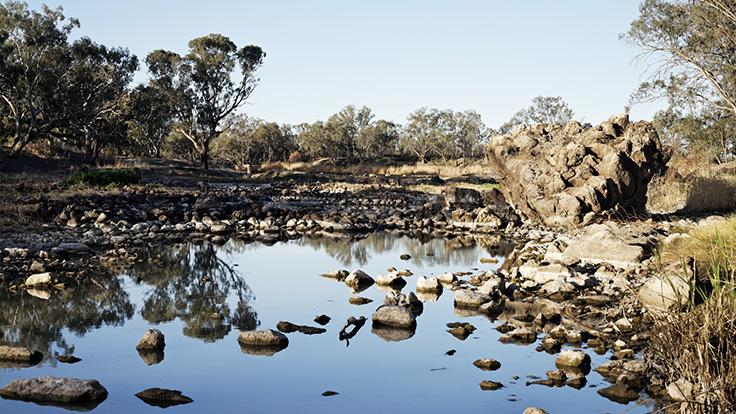Native title

Native title is the name Australian law gives to the traditional rights and interests that indigenous groups have practised, and continue to practise, over land and water.
Native title reflects the close and continued connection indigenous groups have with land and water.
Native title rights and interests may include the right to live and camp in an area, conduct ceremonies, hunt and fish, collect food and resources, build shelters and visit places of cultural importance.
Native title rights are recognised through the native title claim process and formal determinations that native title exists by the Federal Court of Australia.
What are the options for dealing with native title in NSW?
Where native title exists, the NSW Government and NSW Resources are legally bound to follow the processes set out in the Native Title Act 1993 (NT Act). For the purposes of processing applications, NSW Resources considers native title to exist until proven otherwise.
For mining and assessment leases, this usually requires compliance with the Right to Negotiate (RTN) process, unless the applicant can satisfy the Minister that native title has been extinguished.
For exploration licences, there are several options for compliance with the NT Act:
- Request a standard licence that includes a condition requiring the Minister’s consent before carrying out prospecting activities on land or water where native title might exist. If the applicant wishes to prospect on areas where native title may exist, they must complete the RTN process at that time or satisfy the Minister that native title has been extinguished in the areas on which they wish to prospect.
- Satisfy the Minister that native title has been extinguished before your application is granted.
- Undertake the RTN process or an applicable alternative process provided for in the NT Act before your application is granted.
- Apply for a low impact licence.
It may also be possible to excise areas of land from an application where the Minister is not satisfied native title has been extinguished.
Additionally, the applicant may be able to negotiate an Indigenous Land Use Agreement with the relevant native title parties.
The Guideline: an overview of native title and the Mining Act (PDF, 265.34 KB) provides more information on the above options and outlines NSW Resources' approach to native title.
For information specific to petroleum titles, such as petroleum exploration licences or petroleum production leases, see the Guideline: an overview of native title and the Petroleum (Onshore) Act (PDF, 259.01 KB). The guideline explains how the above options relate to petroleum applications and titles and MEG’s approach to native title for petroleum applications and titles.
Please contact us if you would like more information on the options outlined above.
Assertion that native title is extinguished
When applying for an authorisation, or further approvals, you may assert that native title is extinguished over all or part of the land within the application area. If extinguishment is asserted, applicants should provide supporting evidence in accordance with NSW Resources' Guideline: The preparation of native title assessment reports in support of applications for authorities granted under the Mining Act 1992 and the Petroleum (Onshore) Act 1991. (PDF, 1.01 MB) Usually, this means the submission of a native title extinguishment report referencing copies of the current and historic land tenures for land within the application area.
The guideline:
- provides direction on when an extinguishment report is to be submitted to NSW Resources
- sets out what primary evidence MEG will accept as establishing extinguishment for specific tenures, e.g. freehold, Western Land Leases and Crown roads
- provides references to resources for obtaining copies of supporting documentation
- contains a sample native title extinguishment report with supporting documents
- provides a template for guidance on how reports should be presented and supporting material collated.
The Minister administering the Mining Act 1992 must be satisfied that native title is extinguished before granting an application or further approval without compliance with the NT Act. If this standard is not met, or if native title is established over part of the area of interest only, the NT Act must be complied with in another way.
- Guideline: The preparation of native title assessment reports in support of applications for authorities granted under the Mining Act 1992 and the Petroleum (Onshore) Act 1991 (PDF, 1.01 MB)
- Annexure B report checklist (DOCX, 38.92 KB)
- Annexure C report template (DOCX, 46.47 KB)
- Annexure D of the guideline example supporting documents (PDF, 15.02 MB)
The Right to Negotiate process
The Right to Negotiate guideline (PDF, 196.86 KB)was developed to set out how the ‘right to negotiate’ process (RTN) under the NT Act is applied to proposed acts under the Mining Act 1992 and Petroleum (Onshore) Act 1991.
The guideline has been developed to provide guidance for those undertaking the RTN and give answers to some common questions. It has been developed following consultation with industry and other stakeholders.
Application of the native title infrastructure facility process to mining leases for ancillary mining activities
The infrastructure facility process under the NT Act may apply to mining leases for ancillary mining activities, instead of the RTN process. The Guideline: Application of the native title infrastructure facility process to mining leases for ancillary mining activities is currently under review.
If you would like to discuss the infrastructure facility process, please contact the Native Title, Land Access and Legislation team on MEG.nativetitle@regional.nsw.gov.au.
For further information
NSW Resources' Minview system contains useful spatial information for applicants and title holders, including layers showing where native title exists and where it is extinguished, the location of native title claims, and other useful information.
Information on native title and native title processes can also be found on the National Native Title Tribunal website.
Assessments and Systems
Phone: +61 (0)2 4063 6600
Email: titles@regional.nsw.gov.au
Postal address: Assessments and Systems, NSW Resources, Department of Primary Industries and Regional Development, PO Box 344 Hunter Region Mail Centre NSW 2310
Office: 516 High Street Maitland NSW 2320